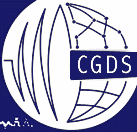 |
|
 |
|
I n f o r m a t i o n |
|
|
Centre of Geophysical Data Studies and Telematics Applications (CGDS) was founded on 15 January 1991 as an effort of Institute of Physics of the Earth (IPE) of Russian Academy of Sciences (RAS) and International Lithosphere Programme - an ICSU/IUGS/IUGG programme devoted to geodynamical studies based on joint comprehensive analysis of geophysical and geological data. Following this line in 1991-1994 CGDS research activities have focused on artificial intelligence and pattern recognition studies in applications to earthquake prone-areas and grand motion data studies. In December 1994 CGDS became one of the five key-nodal members of the European-Mediterranean Seismological Centre (EMSC) in charge of World-Wide earthquakes Strong Motion Data Base (SMDB). Working in close collaboration with other EMSC key-nodal members (LDG (France), Institute of Geophysics (Rome, Italy), Institute of Geography (Madrid, Spain), Geoforschung Centrum (Postdam, Germany)), CGDS has provided engineering seismology data to more than 50 European seismological institutions - members of EMSC; CGDS, at the same time, distributes EMSC earthquakes rapid (24 hours) determination data among Russian seismological institutions. In 1991-1996 EMSC and CGDS completed together numerous joint research projects. CGDS has permanent staff of 41 members including 23 scientific researches and 15 technicians. 9 students work on their thesis at CGDS in connection with different projects of the centre. CGDS has direct 1 Gigabit/sec fiber optic connection with Internet provided by Moscow Lomonosov State University MSU-NET. It is one of the fastest Internet connection speed in Russian Academy of Sciences. Being based on the nodes, CGDS has implemented and developed wide toolkit of teleworking tools. The tools are used in CGDS teamwork projects in geophysics and telematics applications with numerous Russian and foreign organizations. The technical base helps CGDS to play active role in major telematics applications of European Union projects in CIS countries. Among these projects are STACCIS (1996-1999), WISTCIS (2000-2003), TELEBALT (2001-2003), TELESOL (2002-2005). Since 1993 CGDS plays active role in international association EDNES (Earth Data Network for Education and Scientific Exchange), providing major contribution to functioning of EDNES Russian branch. Following this line CGDS took active part in numerous distant and face-to-face educational and training projects led by EU, UNESCO, UNIDO, UNDP, etc. In 1995 CGDS started active collaboration with World Data Centres System of International Council on Science (ISCU) and in 1998 with ICSU Committee on Data for Science and Technology (CODATA). Working in collaboration with World Data Centre A (Boulder) and B (Moscow), CGDS since 1997 develops one of the largest Internet-based geological data base SPIDR (Space Physics Interactive Data Resource). Head of CGDS Prof. Alexei Gvishiani has been elected as Vice Chairman of ICSU Panel on World Data Centres (1996) and CODATA Vice President (2002). The main directions of CGDS research and data activities are:
CGDS has produced more than 300 publications including five books. The two most recent books published in collaboration with Paris Institute of Physics of the Earth by Springer-Verlag are:
|
|
2000–2004 © CGDS |